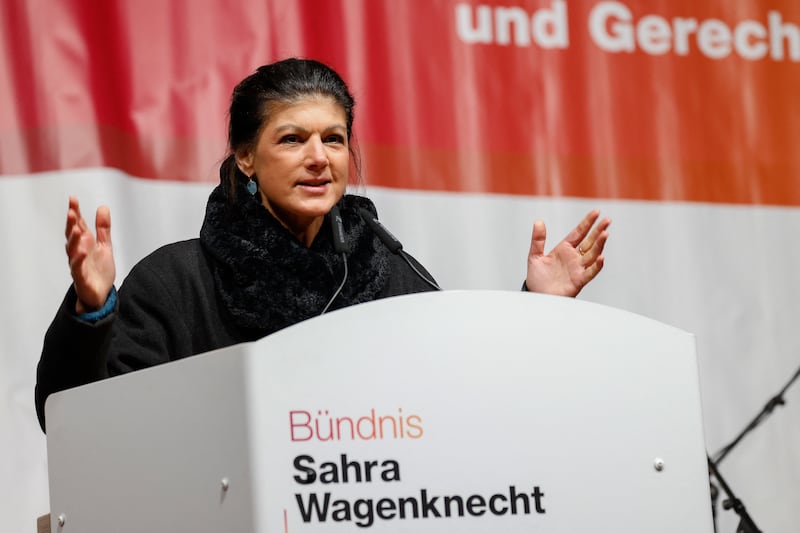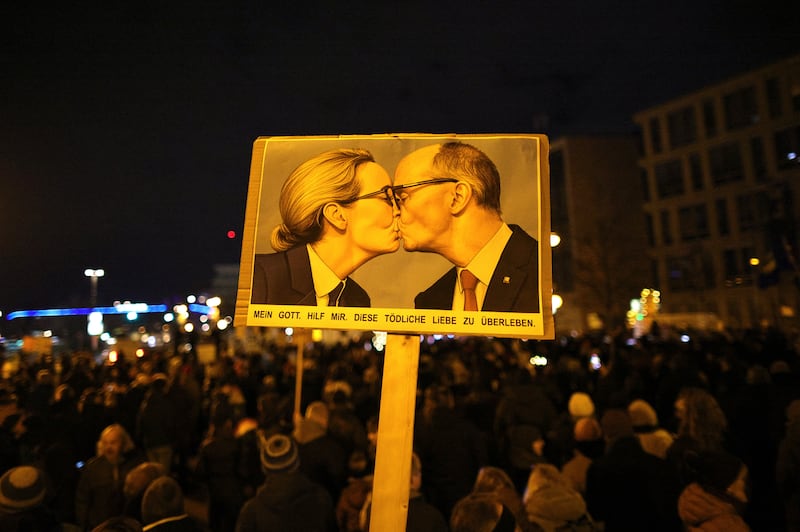Rumours of the German Left party’s (Die Linke) demise were not exaggerated when, three weeks ago, party leaders laid wreaths on the Berlin graves of Rosa Luxemburg and Karl Liebknecht.
While the red carnations and speeches recalled the past – the brutal 1919 murders of the Communist Party co-founders, the Left’s spiritual and political parents – many of the 3,000 people in the graveyard were more preoccupied with their political future after the snap election called for February 23rd.
Just over a year ago the Left’s most strident pro-Russian voice, Sahra Wagenknecht, walked out with one third of the party’s Bundestag MPs to form a new alliance, BSW. Their old party, according to Wagenknecht, had been captured by wokeist culture warriors more preoccupied with pronouns than real voters’ concerns over the cost of living and war in Europe.
Eastern German voters appeared to agree with her diagnosis: elections in three states last September saw a huge swing from the Left to the BSW.
Licking its wounds and now facing an existential federal election, the Left has gone back to basics with a manifesto promising “democratic socialism”: taxing the rich to support the working class through rent caps and energy subsidies.
Climate protection and social justice are “inextricably linked”, it adds. The BSW-Wagenknecht alliance questions climate change policies and prioritises social assistance for German citizens over new arrivals.

Wagenknecht’s pro-Russian, climate-sceptic and anti-migration programme chimed with eastern German voters last autumn, many with memories of cold war ties to the Soviet Union. In chilly campaign appearances around the rest of Germany now, it’s proving a more difficult sell.
Many western Germans in particular see her call for a negotiated peace in Ukraine, and resumption of Russian energy deliveries, as Kremlin kowtow politics.
At a recent rally in Munich, when Wagenknecht bemoaned the “new arms race” in Europe, protestors began chanting “Moscow out!”
Time is not working in favour of the 13-month-old Wagenknecht party, either. Facing into an election seven months early has robbed the BSW of time to build up a campaign war chest and more robust party structures. After a surge last year to double-digit support, it is now struggling to clear the five per cent hurdle.
BSW officials, many of whom enjoyed riding last autumn’s wave of media hype, complain now in public that the same media outlets are “deliberately downplaying” the party to “keep it down”. In private, the same officials accept that some of its policies − in particular warnings over war in Europe − are no longer of primary voter concern. Also damaging are inner-party tensions, particularly over Wagenknecht’s dominant leadership role − and her risky migration strategy.
Last week a hardline migration policy paper by the centre-right Christian Democratic Union passed parliament thanks to support from the far-right Alternative for Germany (AfD).
Seven BSW Bundestag parliamentarians also backed the proposals, prompting a storm of protest in some quarters and a walkout of senior Bavarian party officials. In a statement they warned of a “populist escalation” in the BSW that “promotes unnecessary social divisions and runs the risk of adopting right-wing rhetoric”.
The former Left party members added: “We shouldn’t play minorities off against minority.”
That echoes with their old political home, which is demanding a “solidarity-based” approach to migration that allows new arrivals in Germany to work rather than depend on controversial state handouts.

Following a march of 160,000 people on the CDU’s Berlin party headquarters on Sunday, Left party co-leader Ines Schwerdtner senses an “unbelievable energy that has clarified and focused political positions”.
In the last two weeks alone, she says, her party has gained 11,000 new members to reach its highest level since 2010. “Clearly many people have just been waiting for a left-wing party with a clear path that they can get involved with,” she says.
Years of decline in opinion polls for the party have been halted and support for the Left has risen again, to slide past the five per cent hurdle required for Bundestag representation.
Germany’s political landscape is facing transformation, analysts agree, but how radical the shift depends on whether the Left or the BSW − or both − make it into the next Bundestag.
Analysts it is not a given that the recent migration debate will lure traditional working class voters back to the Left from the AfD, which remains steady in second place in the polls with 21 per cent support.
“Many workers are conservative, distrustful of migrants and transgender people, feel overwhelmed by discussions regarding sexism and racism, and are critical of climate policies,” noted sociologist Steffen Mau in a recent book, Trigger Points.
As BSW leader Sahra Wagenknecht battles for attention in a crowded field, the three-decade political veteran has conceded “the election is, of course, a decision on my political future”.
As her BSW star sinks to four per cent in the polls, her old party has nudged ahead to six per cent and Left veterans feel the wind in their sails.
For them, and others on Germany’s political left, February 23rd will establish like never before whether the last item on their agenda was the split.
- Listen to our The Irish Times on WhatsApp for the latest analysis and chat
- Sign up for push alerts and have the best news, analysis and comment delivered directly to your phone
- Find The Irish Times on WhatsApp and stay up to date











